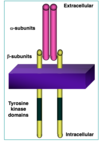Endocrine Flashcards
What is hyperthyroidism?
When there is an increased rate of secretion from the thyroid gland, so it increases in size (swells)
This causes a decrease in body weight, irritability, and an inability to deal with excess heat
What is the morning after pill?
A high dose of progestogen
What are SERMs?
Selective Estrogen Receptor Modulators
Its conformation is different depending on the binding of DNA/transcription factors
Different conformers will cause pro-oestrogenic / partially oestrogenic / anti-oestrogenic effects
Which type of diabetes mellitus is a type of auto-immune disease?
Type 1 - The antibodies attack the pancreas cells
What is a circadian rhythm?
And what can cause fluctuations from the mean average of a hormone?
A 24hr pattern that is similar day in, day out
Fluctuations can be caused by other hormones that promote or inhibit the hormone in question

What are Cortisol and Aldosterone types of?
Steroid Hormones
What type of cells produce calcitonin in the thyroid gland?
C cells
What are the two types of steroid hormones that are prodcued in the adrenal cortex?
Glucocorticoids (eg, cortisol)
Mineralocorticoids (eg, aldosterone)
What types of thyroid hormones are active?
Unbound only
T3 is the most active (due to more being unbound)
Most of each are bound to thyroid binding globulin or thyroid binding prealbumin
What is the main effect of glucocorticoids?
Increase plasma glucose (indirectly)
What are the effects of a defecit or excess in Growth Hormone
Deficit - Can cause dwarfism and aceelerate aging
Excess - Can cause gigantism and acromegaly
From what are Indoleamines derived from?
Tryptophan
Where in the male reproductive system is sperm and hormones produced?
Seminiferous Tubules in the testes
What are the main actions of progesterone?
Produced in the Luteal Phase
Decreases GnRH production
Increases the viscosity in cervical mucous
Increases basal temperature
What is in the periventricular zone of the hypothalamus?
Suprachiamatic neurones - Recieves retinal innervation
Other cells sends input/output to para/sympathetic output neurones in the spinal cord to control the ANS
Neurosecretory cells control the release of regulatory hormones to the pituitary gland
What effect does Thyroid Stimulating Hormone (TSH) have?
Increases the uptake of iodine from blood (pump mechanism)
More Thyroid hormone synthesis via the enzmye iodinase
More thyroglobulin breaks down by lysosomal proteases
What effect does aldosterone have on reabsorption of sodium?
It increases the activity of sodium channels in the tubular membrane

What, with the use of enzymes, does iodinated thyroglobulin release in folicle cells in the thyroid gland?
And how does it become iodinated?
T3 and T4
It becomes iodinated in the folicle cell, which then leaves by exocytosis
What is the main feature that causes a gland to be endocrine?
They are ductless, and so secrete chemicals directly into the blood stream

What receptors do thyroid hormones bind to?
And how do they affect BMR and protein/carbohydrate/fat metabolism
Nuclear receptors –> so effect gene transcription
BMR - They increase the size and number of mitochondria –> causing an increase in ATP production
This causes Na/K ATpase to work more –> releasing more heat
Protein - Altering gene transcription causes more protease synthesis (at high doses) –> and so protein breakdown
Increases protein synthesis (at low doses)
Carbohydrate - Changes in gene transcription will increase the release of insulin (at low doses) or stimulate glycogenolysis (at high doses)
Fat - Changing gene transcription increase the production of lipase, and so increases lipid metabolism
From what are both Cathecholamines (nor/adrenaline) and Thyroid Hormones derived from?
Tyrosine
What is the downside of endocrine communication?
But why can this also be a good thing?
Because many receptors are used, and its done in the blood, it is a very slow process (especially if effecting gene transcription)
However this can mean that any effects are maintained for a long period of time
What are the names of the tissues that make up the…
Posterior Pituitary
Anterior Pituitary
Post - Pars Nervosa
Ant - Pars Distalis

What does insulin trigger the liver to do?
Convert glucose to glycogen (glycogenosis)
Convert sugars to fats













